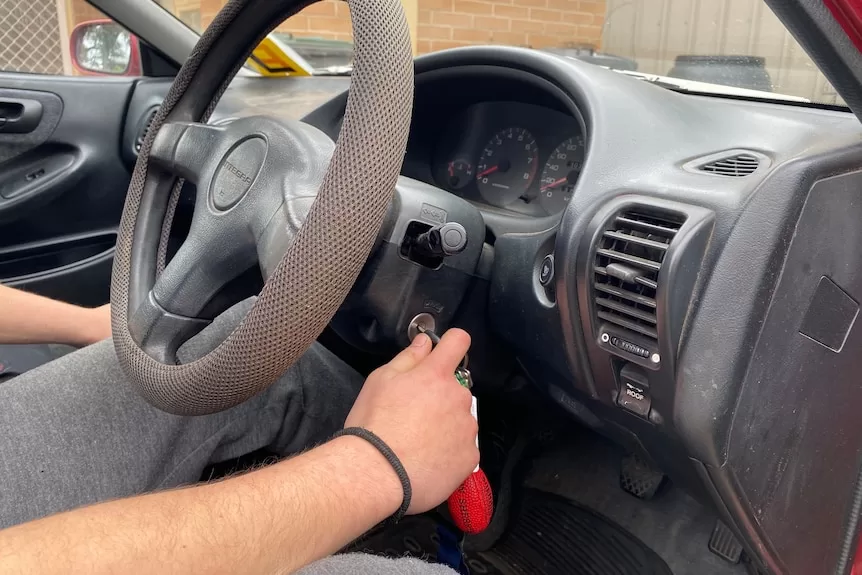-
In short: The average age of a car in Australia is 10.6 years — but many young and inexperienced drivers own a vehicle much older than that.
-
In the past 10 years, automobile experts says car safety improvements have come leaps and bounds, but many Australians wouldn’t know.
-
What’s next? Experts say drivers in one Australian jurisdiction, which has the oldest cars per capita, are even more likely to be without the latest safety features and this could be contributing to the state’s consistently high road toll.
The car your parents or grandparents drove is a far cry from what is getting around on the road today.
The typical car in the 1960s did not have seatbelts in the back seat, the dashboard may have been made of metal and airbags were things of the imagination.
For many, their first car was bought second-hand or came as a hand-me-down from parents, and likely already was years old.
And the older the car, the older the technology — or perhaps, no technology at all.
The Royal Automobile Club of Tasmania (RACT) says car safety improvements have come leaps and bounds in the past 10 years, but some Australians wouldn’t know.
If you’re one of the average Australians with an older car, here’s what’s been happening with safety in the meantime.
ABC News: Luke Bowden
)
Lane departure warning
A camera will detect line markings and notify the driver if the vehicle drifts out of the lane.
It will alert you via a sound, visual display or vibration that your car is about to veer out of your lane but the driver still needs to take action.
It’s aimed at preventing head-on crashes and single vehicle accidents.
Driver distraction detection
Driver inattention is a leading cause of road fatalities in Australia, authorities say.
The advanced versions of driver attention detection will use a camera to monitor the driver’s eyes and head movements to detect drowsiness — just like a passenger would.
The older versions will still detect drowsiness through steering wheel movements and length of time driving and will alert the driver to take a break.
Research by transport regulators has shown this feedback alone can contribute to a positive change in behaviour.
Electronic stability control
Research found vehicles fitted with ESC are involved in 32 per cent fewer single crashes and 58 per cent fewer roll-over crashes.
It uses sensors to monitor the direction of travel and steering wheel position and if a sudden evasive manoeuvre occurs, the technology will activate, automatically braking individual wheels to help to bring the vehicle back on track.
ABC News: Luke Bowden
)
Blind spot warning
As the name suggests, this technology uses a vehicle-based sensor device to detect other vehicles that might be in the driver’s blind spot.
A visual or audible warning will alert when another vehicle is located to the driver’s side and rear.
This technology aims to not only prevent crashes involving other cars or trucks, but also improve the safety of motorcyclists who are more vulnerable road users.
ABC News: Luke Bowden
)
Autonomous emergency braking
Research shows people are more likely to be involved in a rear-end crash than any other type of accident, but AEB technology is helping to change that.
It can detect when the driver is not slowing down quickly enough and it does it for you — reacting faster than the average person can.
In fact, some insurance companies are offering discounts for vehicles that have AEB fitted.
ABC News: Luke Bowden
)
There are now a broad range of standard safety features such as airbags, reversing cameras and anti-lock braking that are found in vehicles in the mid-price range — but the RACT’s Josh Dobie said as your budget increases, so does the number of safety features.
“The technology is available in all cars but when you look at the more luxury range, particularly European vehicles, you tend to see more advanced technology,” he said.
“The newer cars have safety systems built in that are there to assist in saving lives.”
Links between ageing fleet and high road toll
The oldest cars still on the road in Australia are likely to be found in Tasmania, with the average age of a vehicle driven there 13.3 years, compared to the national average of 10.6 years.
Around 20 per cent of that state’s fleet, which is about 82,000 vehicles, are more than 18 years old.
The Road Safety Advisory Council said newer cars are involved in far less fatal and serious crashes than older vehicles, and the state’s ageing fleet could be contributing to the state’s consistently high road toll.
On average, 300 people are killed or seriously injured on Tasmanian roads each year.
“It would be a factor … another factor is there are less public transport options available so people rely on their car more,” chair Scott Tilyard said.
It’s not uncommon to see teenagers driving an older car, despite inexperienced drivers statistically being the most at-risk road users — especially in the first 12 months.
The Road Safety Advisory Council is currently in discussions with the Tasmanian government about how to get younger drivers from regional areas into newer vehicles and are looking at the state of Victoria for inspiration.
“Victoria recently introduced a program where they provide a grant to young people in rural areas to assist them to buy a newer vehicle,” Mr Tilyard said.
“We haven’t made a recommendation to government yet, but it’s one way that provides an opportunity to people who might have a tight budget to buy a safer vehicle.”
LoadingLoading…
